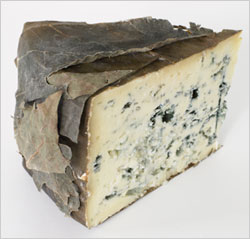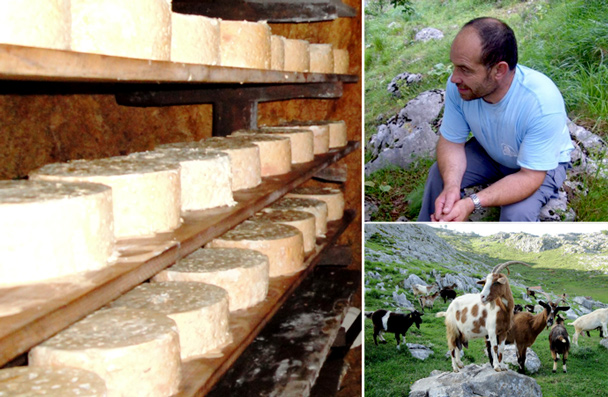José Bada is convinced he has the best job in the world. Admittedly, the cell phone reception at his office isn’t so great, and his competitors can be wolves. But the 50-year-old makes a decent living, his work environment can’t be beat, and he is confident of his product’s quality. “I get to work in the Picos de Europa,” Bada says, referring to the mountain range stretching through north-central Spain that constitutes his office wall. “And the cheese we make is very special.”
That’s an understatement. Cabrales is one of those intensely indigenous cheeses, tightly linked to the tiny region of northwestern Spain where it is made. In fact, only four towns can claim the Cabrales name for their cheese. The region, in the Asturias province, is startlingly beautiful. Bright green grass surrounds the base of soaring granite peaks that even in summer can be topped with snow and are broken only by the occasional alpine lake. Small herds of cows, sheep, and goats graze in the area, the syncopated music of their bells puncturing the brisk air.
That’s the other special thing about Cabrales: It’s typically made from a mix of milk of three animals—sheep, goat, and cow. Bada keeps all three species, and his herd currently measures 60 sheep, 55 goats, and a handful of cows. Every day, as long as the snow isn’t too deep, he and his dogs lead the herd up from his home in the village of Tielve to the steep highlands of the Picos. He’s been doing the same thing for as long as he can remember. “My parents, my grandparents, my great-grandparents, they were all shepherds,” Bada explains. “This is what I was born to do. It’s all I’ve ever known.”
Bada inherited his cheese recipe from those ancestors, and he hasn’t changed it. It starts by mixing the morning milk with the evening milk. The quantities of each animal’s milk vary with the seasons—sometimes it’s more sheep, or more goat—as does the amount of rennet, and the amount of time spent gently heating the mixture. “Every cheesemaker has his or her own process,” Bada notes, “but in general you heat it for about 90 minutes.” The whey is then separated from the paste, and the cheese is set into molds, salted, and left to dry for anywhere between 15 and 30 days.

And that’s where things get really interesting. Because Cabrales cheese—real Cabrales—can’t be cured in what Bada calls an “artificial” room. It has to be left to ferment in one of the dark, dank caves that populate the Picos. When the cheeses are ready, Bada will hike his up to the mountain—either on foot, if there are only a few of the rounds to transport, or by horse if he’s got 20 or 30—and place them in “his” caves for anywhere between one and three months. Like any proud artisan, he won’t tell you where his caves are located, only that they have to be “natural,” not manmade rooms. “Cabrales gets its flavor from nature,” Bada says. “You can’t fake that.”
That flavor is distinct. Cabrales is the bluest of blue cheeses—so blue, in fact, that it often appears almost uniformly gray. Made from raw milk, Cabrales tastes intensely funky and rich, with a bit of spiciness on the finish, and so much mold that those with penicillin allergies—including this writer—have been known to suffer for it. The texture, Bada counsels, should be creamy. “I always say that the way you know a good Cabrales is that, 30 seconds after eating it, you want another bite.”
For centuries, Cabrales was the most idiosyncratic of foods, a cheese that farmers with any kind of livestock would make from whatever milk was on hand. The weather also plays a role. “You have to respect the season, and work with nature,” says Bada. “If it’s sunny out, you do one thing; it it’s rainy, you do another. But it all depends on nature. She’s the one who commands.”
Despite the variations, there’s a council that certifies authentic Cabrales, the Consejo Regulador, and Bada is president of it. The Denominación de Origen ensures that the cheese comes from the proper geographic area, and that, for all its diversity, it meets with certain health and artisanal standards. Right now, there are 29 shepherd-cheesemakers who meet the denomination’s requirements. The council also tries to mediate between the demands of nature and the equally—if not more—stringent requirements of the European Union, including food-safety regulations and wildlife protection.
The Picos de Europa became a national park in 1918, but in the year 2000, the EU included it in the Natura 2000 program, a union-wide initiative designed to protect and promote biodiversity. For the herders in the region, that program has brought decidedly mixed blessings. Although they appreciate the extra protections, shepherds like Bada have found that a certain amount of trouble trails in the policies’ wake. In an effort to restore an endangered species, for example, the program has reintroduced wolves into a park where they were once nearly extinct. And wolves eat sheep and goats. “You can’t leave your animals out at night like you used to,” says Bada. “You have to bring them down from the mountain each day once it starts getting dark. That makes the job much more stressful.”
If the idea of a shepherd’s life being stressful seems somewhat anomalous to those of us tied to our BlackBerries and laptops, Bada promises he speaks the truth. But still, he wouldn’t trade it for anything. “Our animals, our lifestyles, our cheese,” he says, “this is what’s genuine.”
A longtime contributor to Gourmet magazine, Madrid-based Lisa Abend is the Spain correspondent for Time and also writes for The New York Times, Afar, and Bon Appétit. Her first book, The Sorcerer’s Apprentices: A Season in the Kitchen at Ferran Adrià’s elBulli, was published in 2011.

